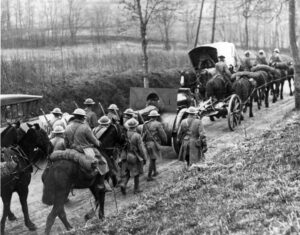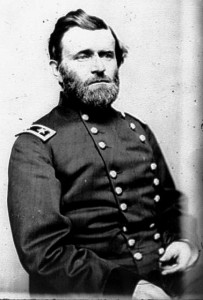Written By: Darren Neely

The 21st Infantry Regiment was constituted in the Regular Army as 2d Battalion, 12th Infantry, on 3 May 1861. After serving in the Civil War in most of the major campaigns of the Eastern Theater with the Army of the Potomac, it was reorganized and redesignated as the 21st Infantry on 7 December 1866. The 21st has seen combat in almost every war or conflict of the United States since 1861, save for World War I. The regiment has established an excellent combat record while serving its country and earned several unit citations. In addition, eleven soldiers from the 21st have earned the Medal of Honor. The motto of the regiment is one simple yet strong word: Duty.

The soldiers of the 21st both past and present are known as “Gimlets.” According to the regimental history, the Gimlet nickname traces its roots to the inter-service athletics of the early 1920s. Teams of the 21st Infantry dominated other regimental teams in every sport so much that they were given the name Gimlets after the hand tool used to bore holes through rocks; the soldiers of the 21st were known to bore holes through their opponents. In addition to being known as Gimlets, the regiment also adopted the unofficial motto of Bore, Brother Bore. After being organized in 1861, the 21st assisted in the defense of Washington, DC, before receiving its baptism of fire at Cedar Mountain on 9 August 1862. The regimental crest portrays a single cedar tree in honor of this first combat action by the regiment.
At Cedar Mountain, the regiment covered the 2d Division of MG Nathaniel Banks’ II Corps as skirmishers, but when they began to advance towards the Confederate lines, they were accidentally fired upon by friendly artillery. A single wounded soldier from the regiment, PVT John L. Younker, crawled back to the lines with a message for the artillery to cease fire. For this action, he became the first soldier of the regiment to earn the Medal of Honor. The regiment went on to serve in combat for the remainder of the Civil War, with perhaps its hardest and deadliest fighting coming at the infamous Bloody Angle at the Battle of Spotsylvania. In all, the regiment earned twelve campaign streamers for its Civil War service.
In 1869 the regiment was deployed to the West to fight in the Indian Wars. As it traveled west, the 21st became the first U.S. Army unit to cross the country by rail.
On 10 May 1869, the regimental band had the honor of performing at the meeting of the Union Pacific and Central Pacific railroads at Promontory, Utah, thus signifying the final step of the transcontinental railroad for the United States. Most notably, the regiment, along with the 4th U.S. Artillery and 1st U.S. Cavalry, served in the Bannock War of 1878. A set of arrows and a rattlesnake, an Indian emblem of war, on the regimental crest reference the eight Indian War campaigns in which the 21st Regiment participated. After its service in the West, the 21st Infantry was assigned to Plattsburgh Barracks, New York, in 1895. During the Spanish-American War in 1898, the 21st Infantry served in Cuba with V Corps and took part in the Santiago campaign.

The regiment fought not only the Spanish, but also the tropical heat, terrain, and the ever-present threat of yellow fever and malaria. The symbol of V Corps can also be found on the regimental shield and distinctive unit insignia, yet another indication of the regiment’s excellent service and proud history.
Following the Spanish-American War, the regiment was sent to the Philippines to fight in the Philippine Insurrection. The regiment took part in three campaigns from 1899 until 1909. The Kaptipunan Sun on the 21st Infantry coat of arms symbolizes the part the Gimlets played in the Philippine Insurrection.
The period around World War I consisted mainly of training and Mexican border patrol assignments for the regiment. The 21st trained over 8,000 soldiers for deployment to Europe as part of the American Expeditionary Forces and had orders to deploy when the war ended in November 1918.
In 1921, the regiment was sent to Schofield Barracks in Hawaii, where it would gain the Gimlet nickname and remain until World War II. During this period, the 21st was assigned to the Hawaiian Division until 26 August 1941, when it was reassigned to the 24th Division (later 24th Infantry Division) The 21st Infantry Regiment, along with other Army units based in Hawaii, suffered casualties when the Japanese attacked on 7 December 1941. The regiment deployed to Australia with the 24th Infantry Division, where it trained for combat in the Pacific Theater and first engaged the Japanese at Tanahmerah Bay, New Guinea, on 22 April 1944. Next up was the American recapture of the Philippines, beginning with landings on the island of Leyte in October 1944.
During that campaign, the 21st spearheaded the capture of the island of Panoan on the southern tip of Leyte, a strategic location that allowed American PT boats to conduct operations against Japanese shipping. The regiment continued to find success against the Japanese, although its next battle would be a costly one for the Gimlets. In November 1944, the regiment engaged strong Japanese forces at Pinamopoan on Leyte where it would fight the deadly battle of Breakneck Ridge. The battle resulted in the loss of 630 men killed, wounded, or missing; Japanese casualties included 1,779 dead. In a testament to the regiment’s costly victory over the Japanese at Breakneck Ridge, the Japanese commander stated that the defeat at Breakneck Ridge broke the back of Japanese forces on Leyte.
The 21st took part in combat operations in the Philippines for the remainder of the war before being sent to Japan for occupation duties, where it would remain until the beginning of the Korean War in June 1950. For its service in World War II, the 21st earned another five campaign streamers, including two with arrowheads for assault landings at New Guinea and in the Southern Philippines. After North Korean forces crossed the 38th Parallel and started the Korean War, President Harry S. Truman committed the United States to defending South Korea. A small group of soldiers from the 21st, about 400 men, would be the first Americans committed to combat. GEN Douglas MacArthur believed that once the North Koreans realized that American soldiers were in combat, they would either slow down their advance or seriously think twice about fighting a war where the American military was now involved.
On 2 July 1950, a force built around 1st Battalion, 21st Infantry, and commanded by LTC Charles Smith disembarked at Pusan, South Korea, and headed north for an eventual engagement at Osan. This unit was known as Task Force Smith and was equipped with outdated equipment and was low on ammunition and supplies. The soldiers assigned to the task force had an average age of twenty years old, and only about one in six had combat experience. Task Force Smith had no significant anti-tank weapons to counter the North Korean armor and was assigned a single artillery battery for fire support. The men of the task force were simply to conduct a delaying action so the Americans and South Koreans could set up defensive lines closer to Pusan.
The North Koreans struck on 5 July with T-34 tanks and a force of infantry estimated at well over division strength that tried to push the small task force from its positions. The enemy quickly bypassed the American troops and LTC Smith quickly realized that he needed to withdraw or risk losing his entire command. Task Force Smith had delayed an entire division for eight long hours. The heroic stand gave the Americans time to bring more troops from Japan. For this delaying action, the 21st Infantry earned a Presidential Unit Citation. The regiment continued to fight delaying actions as the American forces reorganized in the Pusan Perimeter before counterattacking at Inchon. The 21st found itself attacking north, and was well above the 38th parallel by the middle of October.
By November the Gimlets had succeed in reaching Sonchon, a mere seventeen miles from the Yalu River. The introduction of Communist Chinese forces forced the 21st along with the rest of the American and United Nations forces back south. The regiment fought delaying actions, which allowed the main UN forces to withdraw and set up defensive positions just south of Seoul. A stalemate ensued that lasted until the end of hostilities during the summer of 1953. In January 1952, the 24th Infantry Division, including the 21st Infantry, was withdrawn from Korea to become part of Far East Command Reserve. The 21st returned to Korea in July 1953 to guard Communist prisoners at Koje-do Island. During the Korean War, the 21st Infantry took part in ten campaigns, earning two Presidential Unit Citations and two Republic of Korea Presidential Unit Citations.
The 21st Infantry would once again be called on for duty, this time for service in the Vietnam War. The 3d and 4th Battalions were deployed in 1966 and 1968, respectively, to Vietnam, where they would serve with the 196th Infantry Brigade (Light). In February 1969, both battalions became part of the 23d Infantry Division (Americal). The Gimlets assisted in offensive operations aimed at assuring security for the Chu Lai base complex. It was in Vietnam that SSG Nicky Daniel Bacon of Company B, 4th Battalion, 21st Infantry, earned the Medal of Honor for his actions on 26 August 1968 at Tam Ky. On 11 August 1972, with the de-escalation of the Vietnam War, the Gimlets became the last ground combat unit in the Republic of Vietnam to stand down. The 1st Battalion, 21st Infantry, was the first Army battalion to convert to the new “light” formation of the 25th Infantry Division (Light) in 1985. These new “light fighters” were part of the Army’s transformation to create light infantry units whose mission had four distinct parts: mission flexibility, rapid deployment, combat readiness at 100 percent, and Pacific theater of orientation.

The 4th and 5th battalions deployed to Panama in 1989 with the 7th Infantry Division (Light) for Operation Just Cause. In the invasion of Panama, the 5th Battalion air assaulted into Coclectio and secured all its objectives assigned for this operation. Their successful transformation to light infantry units would result in the Gimlets being tasked with yet another transformation as the twenty-first century began. The 21st Infantry soon played an important role in the Army’s transformation to units of action, brigade combat teams (BCT), and highly mobile units deployed with new Stryker combat vehicles. These new Stryker units are very similar to the light infantry units that the 21st helped form in the 1980s in that they are highly mobile, capable of rapid deployment, and, being based in Hawaii and Alaska, have a Pacific theater orientation.
The 3d Battalion, 21st Infantry, was reactivated at Fort Lewis, Washington, on 5 April 2002. The unit deployed to Iraq as part of Operation Iraqi Freedom (OIF), along with the 1st Stryker Brigade Combat Team (SBCT), 25th Infantry Division, as part of the OIF 3 rotation, October 2004-October 2005.
The 1st Battalion, part of the 2d SBCT, 25th Infantry, deployed as regular infantry in its first rotation to Iraq from January 2004 to February 2005. The 1-21 Infantry was assigned control of Kirkuk in February of 2004 with a primary mission of finding and destroying enemy terrorist units and protecting Iraqi civil infrastructure. The Kirkuk area was an especially tough assignment for the Gimlets as it is an area with a highly mixed population of both Arabs and Kurds. The Gimlets also found themselves playing a large role in the first democratic elections held in Iraq in January 2005.
The soldiers of 1-21 Infantry were tasked with securing a city of one million residents and preventing insurgent attacks on polling locations throughout Kirkuk to allow the highest level of voting participation by Iraqi citizens. The Gimlets also rebuilt key city infrastructure, trained Iraqi security forces, and kept the city streets safe. Upon returning home in February 2005, the battalion completed its Stryker transformation. It then deployed to Iraq with the 2d SBCT, 25th Infantry Division, in November 2007.
The 21st Infantry Regiment has established a highly decorated and proud unit legacy in its almost 150 year history. From the slopes of Cedar Mountain to the jungles of the Philippines, and from the 400 brave soldiers of Task Force Smith to the Stryker warriors of today, the Gimlets have indeed lived up to their namesake.
The regiment has undergone several successful transformations, including Regular Army infantry, light infantry, and now as a Stryker unit. They have fought conventional battles against fellow Americans in the Civil War and fanatical Japanese soldiers in New Guinea and the Philippines in World War II. Yet, the Gimlets have also fought battles against insurgent and unconventional forces on the American frontier as well as in the Philippines, Vietnam, and now in Iraq. The tradition of the Gimlets has surely prepared soldiers to be both adaptive and successful when called upon to transform their fighting composition and mission, and when facing the myriad of enemy forces they have encountered throughout the years. There is no doubt that the Gimlets of today and tomorrow will continue this fine tradition of Duty and will continue to urge Bore, Brother Bore.




